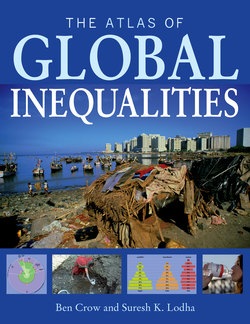Читать книгу The Atlas of Global Inequalities - Ben Crow - Страница 10
На сайте Литреса книга снята с продажи.
Оглавлениеculture, that result in a widening distance between low-ranking employees and executives, countries that are not industrializing and those that are; Hierarchy – advantages within formal organizations, such as rank within an administration, corporation, or army. These causes of inequality arise both from an individual’s initial endowments, of skill and fortune, and from their location in systems of opportunities structured by nation, class, gender, and race. They operate through institutions, such as a corporation or a family, through practices of interaction, including labor hiring, housing allocation, and the borrowing and lending of money, and through the language we use to explain, think about and enact our daily lives. They are, in other words, dispersed throughout all elements of human existence, and they may influence action at all levels, from face-to-face contact to national and international dealings. One pattern evident from the map of the Human Development Index, and throughout the pages of this atlas, is the difference between those who live in the industrialized “North” of the globe, and those who live in the non-industrialized “South”. With few exceptions, birth in a non-industrialized (developing) nation predisposes two-thirds of the world’s population to disadvantage in almost all dimensions of inequality. This happens because the growth of industrial productivity transforms many aspects of society, and the life possibilities of most, if not all, in that nation. We can identify this process as the distantiation of the North from the South, involving also elements of exploitation and exclusion during and since colonial rule. The evidence from historical studies of income and economic production (see pages 16–17) suggests that increasing productivity as the North industrialized was the main force driving this distantiation. There is an irony or paradox that North–South distantiation continues in the 21st century, even as travel and communication times are reduced by technological innovation. Analytical approach The analytical approach that informs this atlas is that of Amartya Sen. In his work on inequality, famine and poverty (1981, 1992, 1999), Sen distinguished some useful analytical categories: Entitlements and capabilities – social and individual relations giving command over a desired functioning, for example, employment of laborers, which entitles them to a wage with which to buy food; Functionings – desired individual outcomes such as a long life or being nourished; Freedoms – a broad set, including political freedoms, economic facilities, social opportunities, transparency guarantees, and protective security. Functionings and freedoms are things that people want to do and to be. In other words, Sen describes inequalities in relation to desirable achievements, the lives that people value. Then, his analysis identifies the specific entitlements and capabilities that enable a
10
